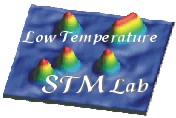|
Single Molecule Imaging, Spectroscopy, Dynamics, and
Chemistry
Our research focuses on nanoscale chemical and physical phenomena with an
emphasis on probing the basic properties of single atoms and molecules in
their nano-environment on solid surfaces. The goal is to obtain detailed
descriptions of single atoms and molecules which form the basis for
understanding chemical and physical processes at surfaces and properties
of nanostructured condensed matter and molecular materials.
The understanding of matter and its interactions with the surrounding
at the atomic and molecular level is the central theme of our research
program. The ability to control chemistry at the level of individual atoms
and molecules underpins the way they interact and use the available energy
to affect chemical transformation. The study of magnetism down to single
atoms allows the understanding of how the electron spins play a role in
chemical and physical processes.
The scanning tunneling microscope (STM) is a tool which not only allows
us literally to see individual atoms and molecules but also to manipulate
and spectroscopically characterize them. It is an all-purpose tool and is
in effect a nanoreactor carrying out reactions with atoms and molecules in
the nanocavity of the tunnel junction. Since the coupling of electrons to
the nuclear motions provides the driving force for chemical
transformation, the STM with its tunneling electrons can be tuned to
induce atomic and molecular motions and to dissociate and form chemical
bonds.
Tunneling electrons can be spin polarized. The STM can be used to probe
magnetism and the effect of magnetic impurity on superconductivity and
other solid state phenomena associated with the electron spin.
We have demonstrated that chemical analysis with the STM is possible
with inelastic electron tunneling spectroscopy (IETS) and have reached the
limit of sensitivity of vibrational spectroscopy, that of a single bond.
The ability to measure spatially resolved vibrational intensity with
sub-Angstrom resolution in single molecules makes it possible to directly
determine quantitatively a number of fundamentally important physical and
chemical processes.
The STM can be used effectively to probe solid state and molecular
materials at the spatial limit. Its versatility is reflected in a wide
range of problems which have been successfully investigated. These include
intramolecular energy transfer, energy dissipation resulting from bond
breaking, chemical identification and structural determination of
reactants and products involved in the making of individual chemical bonds
and intermediates in multistep reactions, the coupling of electrons to
nuclear motions via individual molecular orbitals (orbital-specific
chemistry), electrical conductivity through single molecules (molecular
electronics), classical and quantum diffusion (tunneling) of single
hydrogen atoms, the spatially dependent interactions between two
molecules, and the fundamental motions of molecules (rotation, vibration,
translation).
|



